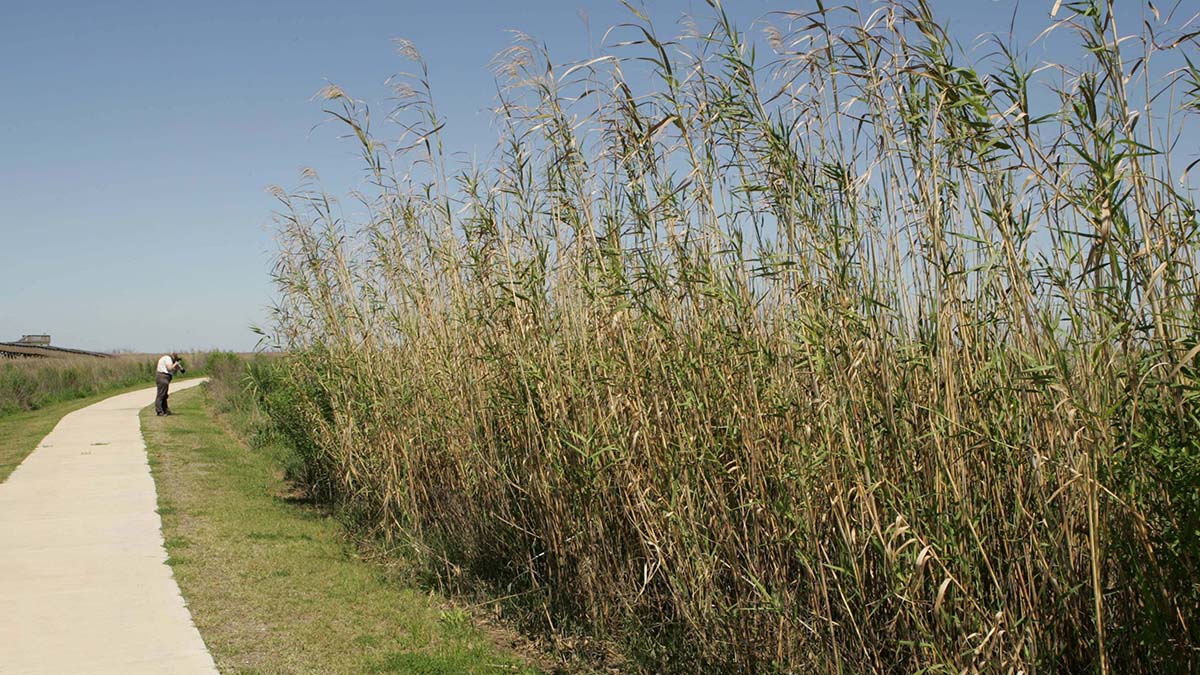Finding its way here from Eurasia on ships in the late 1700s to early 1800s, phragmites australis, also known as common weed, a perennial grass, is now everywhere. It is unrelenting in its absorption of our beautiful Maryland natural landscape spreading at twice the rate of other species. This nonnative, invasive grass has infiltrated Maryland’s fresh and brackish wetlands, including the edges of ponds, creeks, streams, and our jewel, the Chesapeake Bay. It spreads fast and furious via aboveground stolons, underground rhizomes and seed.
In Greek, “phragma” means “fence”. This is an appropriate name for a plant that can form a wall-like barrier wherever it takes hold achieving heights of 15 to 20 feet. Thick walls and masses of phragmites change the natural wetland areas of Maryland altering the flora and fauna of those delicate ecosystems. This grass creates a monoculture, striking down other plants and completely taking over by blocking sunlight and greedily claiming the soil. It even exudes a chemical from its rhizomes that kills other plants. A monoculture is rarely a good thing as the single plant depletes the soil for its own enjoyment and gives nothing in return to neighboring plants.
Native animals do not typically use phragmites as a food source and rarely use it for cover. One exception is the red-winged blackbird that may nest in this grass. However it would also nest in other native plants such as cattails. It makes a hotbed breeding ground for mosquitoes due to its thick mass and proximity to water. Despite its many negative aspects, phragmites can make an effective erosion control in some areas due to its deep root system. The Smithsonian Environmental Research Center has discovered that it has storage capabilities for carbon and can store more than three times as much as native plants which may combat sea level rise. It’s sometimes used in England for those charming thatched cottage roofs. Native Americans used it for weaving baskets and mats, making pipes and arrows. It is currently being studied for use as a bioenergy source.
Attempting to walk through an area of phragmites by human or animal is very difficult if not impossible. The rough texture of its leaf surfaces and sharp leaf edges can cut into the skin leaving painful welts. It blocks views of ponds and other wetland areas and reduces recreational pursuits such as fishing, bird watching, and hunting.
Efforts have been made to eradicate this pest but it is a difficult and often ongoing task. The controls most often enlisted, singly or in combination are glyphosate herbicides formulated to be safe near bodies of water, controlled burning (where allowed; check local ordinances), cutting (late July is best), draining and goat grazing where goats are allowed. For herbicide use, be sure to get a permit from Maryland through the Maryland Department of the Environment or your local government’s Critical Area initiative, or get professional help. The early spotting of this trespasser will ease tedious eradication.
Controlling this plant is not a onetime shot; the plant is stubborn, digging its heels in like Taurus the bull and coming back at full throttle over and over again. These techniques must be done multiple times and consistently in an effort to rid the landscape of this pest. Digging up this plant is not recommended. The rhizomes can descend as much as 18 inches or more below ground and can grow up to 30 feet annually; up to a mile horizontally over time. Broken pieces of root will reestablish themselves as thriving plants.
Unfortunately, phragmites enjoys rough treatment and the disturbance provided by attempts to destroy it. More often than not, it comes back stronger than ever from these attempts. In areas where phragmites does not exist, it just takes a storm to wash rhizomes ashore to begin the replication process soon resulting in huge areas of this noxious grass. The thousands of seeds produced from the plumes of one plant are also carried by birds, the wind and other animals to start new clutches of phragmites.
It was recently discovered that Maryland also has a native phragmites plant though most of it is long gone due to the wild spread of the Eurasian variety which has killed out most of the native. Some lingering stands of the native variety, less aggressive in nature than the Eurasian, remain in limited quantities in the Delmarva area. It is believed that Maryland has most of the remaining native plant.
Maryland is plagued by many interlopers and phragmites is one of the most visible and widespread. If you have this grass on your property and you are interested in ridding your landscape of it, seek professional help and advice. Remember, a permit may be needed for some eradication measures. Good luck!
Find additional information on phragmites at:
U.S. Department of the Interior, https://www.doi.gov/
Maryland Department of the Environment (MDE), www.mde.state.md.us/epsc/wmapermit.html.
Chesapeake Wildlife Heritage, https://www.cheswildlife.org/
Barbara has maintained over 80 acres of forest land in Maryland since 2000. Phragmites is a constant foe. Barbara can be reached at [email protected].

Let's keep in touch!
Keep up with the latest OutLook by the Bay information by signing up here. We promise not to waste your time.


